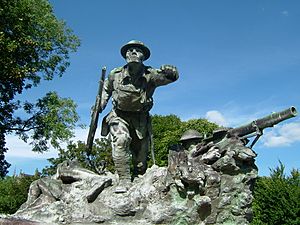Cameronians War Memorial facts for kids
The Cameronians War Memorial is a special monument found in Kelvingrove Park in Glasgow, Scotland. It was built to remember the brave soldiers of the Cameronians (Scottish Rifles) regiment. These soldiers served and gave their lives in the First World War (1914–1918) and the Second World War (1939–1945). The memorial features a bronze sculpture with three figures, showing a scene from a battlefield. It's an important historical site and became a protected building in 1988.
Contents
About the Memorial's Design
The memorial's powerful sculpture was created by Philip Lindsey Clark. He was an artist who also served as a soldier in the First World War. This experience helped him understand what soldiers went through. His design shows three bronze figures of soldiers, a bit larger than real life. They were made by the Manenti foundry in London.
What the Figures Show
The sculpture shows a dramatic moment:
- One soldier is in a trench, firing a Lewis machine gun.
- Next to him, a sergeant moves forward with his rifle. He stands for victory. Some believe he looks like Pipe Major Jimmy Sanderson from the Cameronians.
- Further away, an officer is shown wounded. He represents the sacrifices made by soldiers.
The statue stands on a strong grey granite base. This base is raised on three steps and is surrounded by hedges and a metal fence.
Messages on the Memorial
The memorial has several plaques with important messages:
- The main plaque on the front remembers "ALL RANKS / THE CAMERONIANS (SCOTTISH RIFLES) WHO, / TO UPHOLD LIBERTY AND JUSTICE IN THE WORLD, / LAID DOWN THEIR LIVES IN THE TWO WORLD WARS 1914 – 1918 AND 1939 – 1945".
- Another plaque explains that the Cameronians regiment was officially ended in 1967 and 1968. This marked the end of their long connection with Glasgow.
- A plaque on the south side has a poem that starts: "O VALIANT HEARTS, WHO TO YOUR GLORY CAME / THROUGH DUST OF CONFLICT AND THRO' BATTLE FLAME".
- On the north side, a plaque reads: "BE THOU FAITHFUL UNTO DEATH AND I / WILL GIVE THEE A CROWN OF LIFE".
- At the back, another plaque lists all the places around the world where the regiment fought.
History of the Memorial
The Cameronians War Memorial was officially revealed on August 9, 1924. This was just five days after the tenth anniversary of the First World War starting. The ceremony was led by Sir Douglas Haig, a very important military leader during the war.
Later, more parts were added or updated:
- In 1947, a plaque was added to remember those who served in the Second World War.
- The original stone base wore down over time, so a new, stronger granite one was put in its place in 1958.
- After the regiment was disbanded in 1968, another plaque was added to mark this important event.
- The memorial was recognized as a special historic building in 1988. It was also carefully restored in 2009 to keep it looking its best.
Other Cameronians Memorials
The Cameronians regiment is also remembered in other places:
- In Douglas, South Lanarkshire, there's another memorial built in 1892. It celebrates 200 years since the regiment was first formed. This memorial shows the regiment's first leader, James Douglas, Earl of Angus.
- Another memorial on the Douglas Estate marks the day the 1st Battalion of the Cameronians was disbanded in 1968.
The artist, Philip Lindsey Clark, also created a similar soldier sculpture for the Southwark War Memorial in 1922. Another artist, Albert Toft, made a similar soldier statue for the Royal Fusiliers War Memorial.
Images for kids




